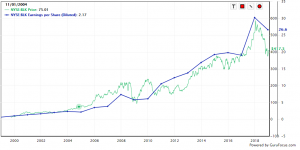BlackRock Funds
BlackRock funds may have a place in your investment plan, but watch the costs
By: Robert F. Abbott, freelance writer and author
BlackRock the Company

- $4.6 trillion in assets under management,
- More than 70 offices in 30 countries, and
- More than 135 investment teams.
It has a commanding presence among institutional investors (pension funds, banks, insurance companies), but among consumers is likely best known for its IShare ETFs.
The company got its start in 1988 as a risk management department within The Blackstone Group L.P., to “…provide institutional clients with asset management services from a risk management perspective.” (Source)
Because of internal confusion, the department changed its name to BlackRock in 1992. Three years later it split from Blackstone to become an independent company, and in 1999 went public (see Wikipedia for more information).
BlackRock Funds
While the company’s institutional and iShare operations get the most attention, it does have a stable of mutual funds. I counted 50 funds on its website (May 27, 2016), many of them for institutional investors only.
Of those available to individuals, most have a front-end or back-end load; in other words, you need to pay extra fees, and that’s always a red flag for careful fund buyers. Note, though, that discounts may be available if you buy at least $25,000 worth of any one fund. See each fund’s Fact Sheet, Summary Prospectus, or Prospectus for details.
Unlike other fund companies, such as Vanguard, it makes no claim to low-cost leadership. Instead, BlackRock emphasizes its client-focus and to some extent, harks back to its risk management past. This statement comes from its website:
“We’re passionate about our work and intensely focused on performing at the highest levels. To get there, we strive to out-think and out-work competitors and find the best balance of risk and return across all investment styles on behalf of our clients.”
Beyond Mutual Funds
If you already have a diversified portfolio of funds, and want to add a growth component to it, you might consider BlackRock stock, rather than its mutual funds (this is a suggestion for further research, not a recommendation). On March 17, 2015, I profiled and analyzed BlackRock as a value stock for GuruFocus.com:

As the title of the article suggests, the company was fairly valued at the time, based on standard fundamental value metrics. And, importantly, its net income and earnings per share kept growing: The price per share increased from $14 in 1999 to $365.09 at the close of trading on May 27, 2016, a 26-fold increase in 17 years.
Since January 2018, though, the stock had slipped considerably (as of early February 2019); the green line on this chart shows the stock price and the blue line shows earnings per share (EPS):
Had its earnings not decreased as well, this might have represented a good entry point, but now we will need to wait.
BlackRock Funds: Conclusion
Any search for mutual funds may bring up BlackRock funds, given the company’s size and reach. While the company’s funds will have the backing of one of the industry’s strongest players, consider the possibility you may have to pay a front- or back-load fee. Such fees erode your short- and long-term returns so consider alternatives that might give you the same basket of companies without a fee. And, keep in mind that BlackRock stock, rather than its mutual funds, might also offer an investment opportunity if it fits your circumstances.
Next
Read about two other giant mutual fund companies, Fidelity Funds and the Vanguard Group
